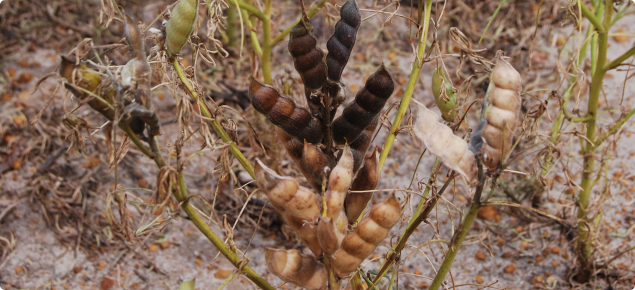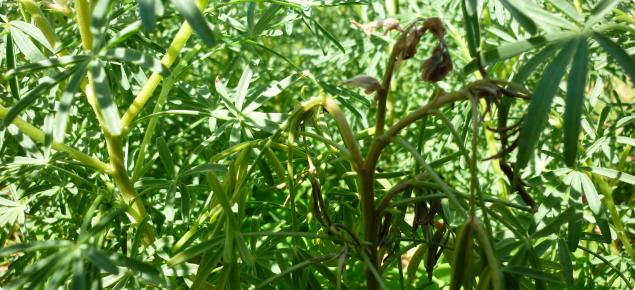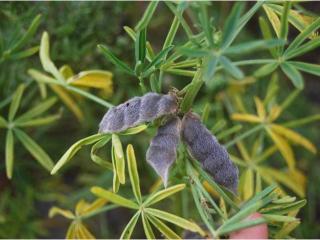Bean yellow mosaic virus (BYMV) infection in narrow-leafed lupin can cause three main symptom types. When infection occurs before pod set, the most common symptom is the necrotic (BYMV-N) symptom that kills the infected plant. There is also the less common non-necrotic (BYMV-NN) symptom causes stunting without killing the plant. When plants are infected after pod set, black pods develop (black pod syndrome or BPS).
The BYMV strains which are endemic in south-western Australia are not seed-borne in lupins, unlike overseas strains.
Symptoms
BYMV-N
Initial symptoms are necrotic streaking of the youngest portion of the shoot, which bends over causing a characteristic ‘shepherd’s crook’ appearance. The growing tip dies, and leaves become pale, wilt and fall off. Necrotic streaking and blackening then spread throughout the stem causing the plant to die. Plants infected early die quickly and do not produce seed. When old plants become infected, the necrotic symptoms are slower to spread and may be restricted to some branches or the section of the plant near to the infection site. These shoots die and their pods blacken and fail to fill while the rest of the plant grows normally.
BYMV-NN
Non-necrotic symptoms on younger leaves show pallor, mottling and leaf deformation and the affected plant is stunted. Sometimes, the death of growing points causes fleshy, expanded leaves to develop on the rest of the plant. Infected plants produce few seeds and endemic BYMV strains are not seed-borne.
Black pod syndrome
Infection after pod set leads to pods turning black and necrotic stem streaking. Leaves turn yellow and drop. Seeds will fail to develop. Varieties vary in symptom development.
Sources of virus
The main source of BYMV is infected clover plants in adjacent pastures. The virus is seed-borne in clover and survives from one growing season to the next in the pasture seed bank. Clover weeds in lupin crops are an additional source if not controlled. Perennial native legumes in adjacent bush may occasionally act as BYMV reservoirs.
If there are no internal clover weed sources, BYMV infection is highest near the edge of a lupin crop close to pasture, especially at its windward edge. For BYMV-N, there is only a brief period between initial symptom formation in young plants and their death, so incoming aphids can only acquire the virus from infected lupin plants for one to two weeks. Infection incidence declines rapidly with increasing distance into the crop. Plants infected with BYMV-NN remain green and attractive to aphids. They therefore provide a continuous source of infection within the crop so aphids spread it away from the crop edge at a faster rate.
Aphid vectors
BYMV is spread by aphid species that colonise lupins, including green peach (Myzus persicae), blue green (Acyrthosiphon kondoi) and cowpea (Aphis craccivora) aphids, as well as by migrants of common non lupin-colonising species, especially oat (Rhopalosiphum padi) and turnip (Lipaphis erysime) aphids. It is transmitted non-persistently, that is, an aphid picks up the virus within one to two seconds while probing on an infected plant, but the virus is then lost when the aphid probes one or two healthy plants.
Yield losses
Infection of plants with BYMV when they are young causes greater yield losses than infection that occurs when they are older. On an individual plant basis, BYMV-N causes high yield losses as it kills young plants so no seed forms on them. On the whole crop scale, BYMV-NN has greater potential to cause losses as it spreads to more plants. When all plants in a crop become infected with either type of BYMV, yield losses can reach 80%. Plants that develop black pods resulting from late season infection will not produce any seed.
Influence of weather
Rainfall events in late summer and early autumn are associated with greater spread of BYMV. This is because rainfall stimulates plant growth before the crop growing season and provides hosts (clovers, weeds and volunteer crop plants) that encourage rapid aphid multiplication and BYMV spread in clover plants. When crops emerge, aphid flights invade the young plants bringing BYMV with them and spread begins early. When there is little or no rain, few plants are available to support aphids before crops are sown, so they take much longer to build up and arrive much later. In low risk areas, this scenario occurs more frequently than in high risk areas.
Management
The extent of BYMV spread in crops depends on many factors. The most important include:
- Time of aphid arrival. Early aphid arrival favours earlier and more extensive spread and greater yield losses.
- The source of the virus. As spread declines rapidly over distance, infected pastures adjacent to crops are much more important sources than infected pastures further away. If abundant clover weeds remain uncontrolled within the crop, they may result in greater spread than external sources.
- Abundance of colonising and non-colonising aphids during the growing season. This increases BYMV spread in the crop.
- Lack of groundcover; sparse stands; poor canopy development; heavy grazing of nearby pasture; paddocks with large perimeter to area ratios; and extended growing seasons. All these factors increase BYMV spread.
An integrated disease management approach is needed to control BYMV in lupin crops:
- Sow early at high seeding rates using narrow row spacing to promote early crop canopy coverage. This deters aphids from landing and shades over early infected plants, denying aphids access to them. High plant densities dilute the proportion of plants that become infected and increase compensatory growth of healthy plants.
- Direct drill into retained stubble. Groundcover reduces aphid landing rates before a crop canopy develops.
- Sow a non-host crop (for example, cereal) border strip between crops and adjacent pasture. Incoming aphids lose the virus when they probe the non-host which helps to decrease spread into the crop from an external source.
- Avoid paddocks with large perimeter to area ratios. This reduces exposure of the crop margin to adjacent BYMV-infected pasture.
- Control clover weeds effectively. This minimises potential virus infection sources within the crop.
Note: Insecticides applied to crops are ineffective at controlling BYMV.




